Probably the most well-known monster ever imagined is Mary Shelley’s Frankenstein. Her book, published in 1818, was both a horror story as well as a science fiction story and is often considered the first true science fiction tale. It told the story of a scientist who created a living creature from dead human parts. Universal Studios used the basis of the story in creating its’ Frankenstein movie in 1931, the same year it produced Dracula. Universal had produced a half dozen or so monster movies in the 1920s but this really started their series which became known as the Universal classic monster series and would run into the 1950s. In the late 1950s Universal packaged a group of these movies into their Shock Theater package and licensed them to television stations. Around the country a monster craze started as local TV stations picked up the package and created their own show to present the movies to viewers. I fondly remember Shock Theater in the Tampa Bay area where I grew up which was broadcast on Friday nights at 11:30 and featured Shock Armstrong, the all American ghoul. Most TV stations would have their own horror host present the movies and many became well known around the country, some still to this day. This is how my love of these classic monsters developed and how I developed my enjoyment of modeling such creatures.
[two]Around the time of these late night monster movie shows Aurora Plastics had already been in business for a few years. Starting in the early 1950s they were producing plastic model kits which consisted mostly of planes and automobiles and had branched out into a historical figure line of kits. Around 1960 Aurora obtained a license from Universal Studios to produce their Frankenstein plastic model kit, the first such fantastical plastic model kit ever produced. This was obviously a result of the popularity of the Universal Monster Shock Theater licensing program. The reception for this kit was amazing with the kits flying off the shelves as fast as Aurora could produce them. Aurora had their equipment running around the clock to meet demand and quickly added other classic monsters to their product line such as Dracula, the Wolfman, the Creature, and others. But the model that started it all was Frankenstein.[/two] [two_last] [/two_last]
[/two_last]
I fondly remember seeing these kits on the shelves of the local dime stores in my youth. In the early 1960s almost every boy built at least a couple of plastic models and up to that point they were primarily airplanes or automobiles although some modelers had branched out into the figure kit models. But when this first monster model hit the shelves it was a revelation for young modelers. The Shock Theater shows around the country whet the appetites of young modelers to a new genre and the Aurora Frankenstein was the first such kit. It came in the classic Aurora “long” box with box art by James Bama showing the monster in a graveyard scene with a castle in the background. The box art used the classic Universal monster from the movie of the creature portrayed by Boris Karloff with the make up being done by Jack Pierce. (Mr. Pierce was a make-up artist for Universal and would become responsible for the make-up on many of the monsters in their movies.)
[two]As I discussed in my previous column many modelers were very disappointed upon opening the box and seeing what the model inside actually looked like. It was not a very accurate copy of the box art but it did portray Frankenstein reasonably well. The model itself had the monster in a similar pose but walking about a graveyard scene with a tombstone and grave markers as the back drop. The face though was rather bland and a very poor rendition of the Boris Karloff monster from the movies. But even with these problems the kit was a huge hit and Aurora could barely meet the demand. This is my recent build of this classic model and you can see how different the model is from what was displayed on the box.[/two] [two_last]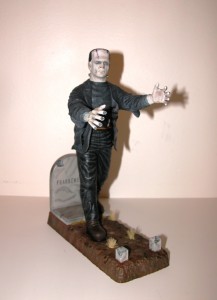 [/two_last]
[/two_last]
[two] [/two][two_last]Aurora produced one more model in the Frankenstein line from the 1935 Bride of Frankenstein sequel to the original movie. The movie is considered possibly the best of the classic Universal horror movies and featured the creation of another monster in the form of a woman. Of course the monster falls in love with her but is spurned when she sees what he looks like. The model was introduced in 1965 and was partly produced in an attempt by Aurora to get girls interested in model building. I don’t know if that worked or not but this kit is one that any modeler who builds such models and collects the original 13 Aurora monsters definitely wants in their collection. Here is my take on this classic Aurora kit.[/two_last]
[/two][two_last]Aurora produced one more model in the Frankenstein line from the 1935 Bride of Frankenstein sequel to the original movie. The movie is considered possibly the best of the classic Universal horror movies and featured the creation of another monster in the form of a woman. Of course the monster falls in love with her but is spurned when she sees what he looks like. The model was introduced in 1965 and was partly produced in an attempt by Aurora to get girls interested in model building. I don’t know if that worked or not but this kit is one that any modeler who builds such models and collects the original 13 Aurora monsters definitely wants in their collection. Here is my take on this classic Aurora kit.[/two_last]
For many years this was the only Frankenstein model available. Aurora went out of business in the mid-1970s and when that happened their line of plastic model kits were no longer available. There were still many on shelves in stores but when those were sold out there were no more. Monogram plastics purchased the assets of Aurora at the time but production of the monster models would remain in stasis for many years. In 1983 Monogram re-released many of the Aurora classics in a new style box which was square shaped rather than the classic Aurora “long box” style. While most modelers would have preferred the classic box format at least the original monster models were once again available, including Frankenstein.
[two]It was about this time that the “garage kit” closet industry was starting with small operations producing resin models. One of the most popular products were Frankenstein models. The garage kit industry usually does not have to deal with licensing fees as their production runs are very small and hardly worth the effort. One of the first kits released was in 1991 by Dark Horse and was a sculpt of the monster chained to a chair. Randy Bowen, who would sculpt other monsters into products, was responsible for this version of the creature. This was made of cold cast ceramic which is similar to resin. I have seen this model at shows and it always impresses me with the creature portrayed in such agony. This one is painted by Denis Lange. The kit has been out of production for quite some time but can be picked up on eBay infrequently.[/two] [two_last] [/two_last]
[/two_last]
[two]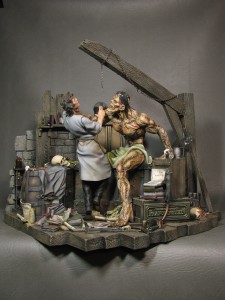 [/two] [two_last]One of the most realistic renditions of the Frankenstein monster was in Bernie Wrightson’s graphic novels. I think if I could imagine what an actual creature made of dead human body parts would look like his interpretation would be the most realistic. Sideshow Collectibles produced a vinyl kit of the Wrightson monster in the lab with Dr. Frankenstein in the 1990s. Because this was a vinyl model I have heard that it was very difficult to assemble but when done correctly it turns into an amazing rendition of Mary Shelley’s creation. I have seen these at a couple of shows and am always greatly impressed by the sculpt and the builder’s take on it. One of the best examples of this kit with great colors is by the amazing Steve Riojas. Here is what he turned this model into with his talents. The model is no longer produced and again can sometimes be found on eBay but typically is fairly costly.[/two_last]
[/two] [two_last]One of the most realistic renditions of the Frankenstein monster was in Bernie Wrightson’s graphic novels. I think if I could imagine what an actual creature made of dead human body parts would look like his interpretation would be the most realistic. Sideshow Collectibles produced a vinyl kit of the Wrightson monster in the lab with Dr. Frankenstein in the 1990s. Because this was a vinyl model I have heard that it was very difficult to assemble but when done correctly it turns into an amazing rendition of Mary Shelley’s creation. I have seen these at a couple of shows and am always greatly impressed by the sculpt and the builder’s take on it. One of the best examples of this kit with great colors is by the amazing Steve Riojas. Here is what he turned this model into with his talents. The model is no longer produced and again can sometimes be found on eBay but typically is fairly costly.[/two_last]
[two]
Horizon produced a vinyl model of the monster back in 1996 and it is one of the most popular that were available. That is probably due to the fact it captured the original Karloff Frankenstein quite closely with the facial characteristics and the body almost identical to the movie creation. This example of it was painted by Ian Wilkinson of Great Britain and he managed to nail the creature from the movie dead on, literally. The kit was rather plain though and included no setting whatsoever, simply the monster itself. Many modelers who have built and painted this kit have added a base or more to accent the figure itself. Once again this kit hasn’t been produced in a number of years and when found on eBay typically commands a good price.
Another company that produced a much sought after vinyl kit of the monster in the ‘90s was Billiken. It was similar to the Horizon model being a very good rendition of Karloff’s monster. It can also be found occassionally on eBay at typically high prices.
[two]As the years passed and Universal produced more classic horror movies about Frankenstein, or with the monster as part of a cast of monsters, Boris Karloff bowed out of the role and other actors were selected to take his place. The first was Glenn Strange who appeared in three of the Frankenstein movies during the 1940s. Karloff actually coached him and played a mad doctor himself who brings back the creature to seek revenge. There have been a couple of models produced of the Strange monster and this version was produced by XO Facto. It was a resin model and a very nice rendition with a bit of a background scene. Here is an example of this model built and painted by Steve Riojas once again.
[two] 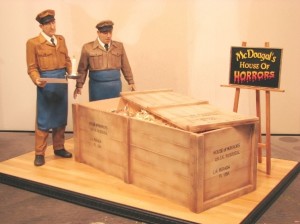 [/two][two_last]Another great kit featuring the Strange monster was from the classic 1948 Abbott and Costello Meet Frankenstein. The kit was produced by Dark Carnival and is extremely rare these days. It depicted a scene from early in the movie when the two bumbling delivery men discover the monster in a crate. I have seen this model one time at Wonderfest and would like to have one of these in my collection if I could.[/two_last]
[/two][two_last]Another great kit featuring the Strange monster was from the classic 1948 Abbott and Costello Meet Frankenstein. The kit was produced by Dark Carnival and is extremely rare these days. It depicted a scene from early in the movie when the two bumbling delivery men discover the monster in a crate. I have seen this model one time at Wonderfest and would like to have one of these in my collection if I could.[/two_last]
[two]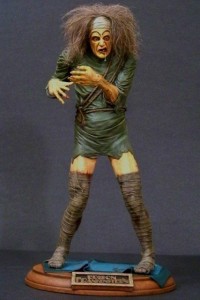 [/two] [two_last]One of the first movie versions of Frankenstein was done by Thomas Edison who received patents for motion picture cameras and technology. As one of his first movie productions he produced the first Frankenstein movie in 1910. The monster was definitely unique and actually a fairly good cut at such a creation for a first attempt. Monstrology introduced a resin model of Edison’s creature in 1993. The kit was a very good recreation of the monster from the movie and as with the movie character, a very unique model. I have never seen a model of the Edison monster in person but am intrigued by it. This picture is a Monstrology Edison Frankenstein by Charlie Coleman.[/two_last]
[/two] [two_last]One of the first movie versions of Frankenstein was done by Thomas Edison who received patents for motion picture cameras and technology. As one of his first movie productions he produced the first Frankenstein movie in 1910. The monster was definitely unique and actually a fairly good cut at such a creation for a first attempt. Monstrology introduced a resin model of Edison’s creature in 1993. The kit was a very good recreation of the monster from the movie and as with the movie character, a very unique model. I have never seen a model of the Edison monster in person but am intrigued by it. This picture is a Monstrology Edison Frankenstein by Charlie Coleman.[/two_last]
[two] With the recent resurgence in the styrene kit market brought about by Moebius Models, Monarch Models, Revell/Monogram, Round 2, and others, there have been a couple of new Frankenstein models released. These two models are produced by Frank Winspur’s Moebius Models. Frank has started producing a number of the Universal classic monsters in styrene kit form and one of his earliest was Frankenstein released in 2009. The model shows the monster coming out of the castle door from an iconic scene in the movie. While not considered a great rendition of Frankenstein it still is a nice model and a reasonable reproduction of the movie scene. Here is my take on this model.[/two] [two_last] [/two_last]
[/two_last]
[two] [/two] [two_last]Moebius followed up Frankenstein himself with their recent release of a new Bride of Frankenstein sculpted by the immensely talented Jeff Yagher. The kit has a great diorama background with a scene from near the end of the movie with the monster and bride on a couch in the lab. This was a styrene kit which keeps the cost down significantly from a resin kit and has been extremely popular. Here is my rendition of this model.[/two_last]
[/two] [two_last]Moebius followed up Frankenstein himself with their recent release of a new Bride of Frankenstein sculpted by the immensely talented Jeff Yagher. The kit has a great diorama background with a scene from near the end of the movie with the monster and bride on a couch in the lab. This was a styrene kit which keeps the cost down significantly from a resin kit and has been extremely popular. Here is my rendition of this model.[/two_last]
[two]Finally returning to the original Aurora Frankenstein that started it all I would like to present one final model. This is the Monsters in Motion Yagher box art rendition of the classic kit. This large resin model was introduced to the modeling community last year and was a huge hit. It truly reproduces the Bama box art in the form of a 3D resin model and is quite impressive when completed. Monsters in Motion have produced about half the original Aurora monster model kits in this box art format over the years and all have been very popular.[/two] [two_last]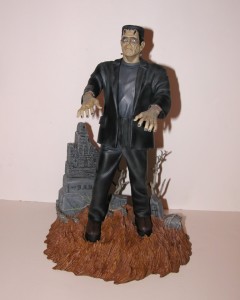 [/two_last]
[/two_last]
These are but a few of the various Frankenstein models now available or which have been produced over the years since the classic Aurora kit of 1961. The Clubhouse online modeling website has a gallery page with most of the various Frankenstein kits presented by modelers who have built these kits (https://www.theclubhouse1.net/museum/modelsfrankenstein.htm). It gives one a good idea of what has been or is currently available. Aurora truly created a monster (hobby) when they released that first monster so long ago.

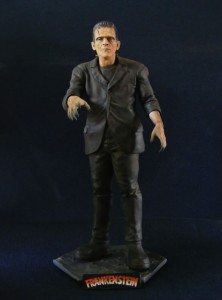











Recent Comments